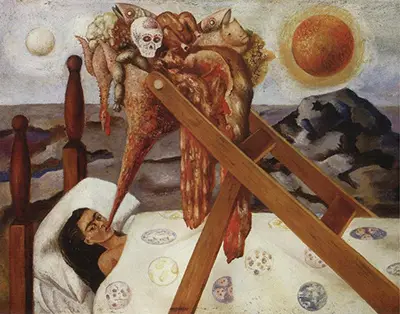Lifelong pain and countless operations resulting from severe injuries sustained in a horrific bus accident in 1925, as well as countless illnesses, rendered Frida bedridden for much of her time.
The piece was painted in 1945 after her latest bout of illness, when she was left emaciated and malnourished. Kahlo was prescribed what she regarded as a 'force-feeding' diet of fattening pureed food, provided directly every two hours.
The painting depicts a bedridden Kahlo, tears in her eyes, lying in bed in the lifeless landscape of the desert, 'illuminated' by both the moon and the sun. The sun in Aztec mythology signifies human sacrifice, Kahlo feeling like she has been somehow sacrificed.
The moon represents womanhood, perhaps the womanhood taken away by her several miscarriages, another result of the cruel accident in her teens. She lies beneath white hospital sheets emblazoned with microscopic lifeforms, symbolizing the relentless infections which attacked her body.
Even in 'Self Portrait with Thorn Necklace and Hummingbird, 1940, Kahlo's expression is composed, as if resigned and tolerating the pain.
In Without Hope, however, all hope and tolerance seems to be gone. Her arms are restrained beneath the sheets, leaving her powerless to control her fate. Above her body looms a huge funnel feeding into her mouth, a morbid cocktail of fish heads, dripping carcasses and other macabre food piled and overflowing from the top.
The large wooden easel constructed by her father to enable Kahlo to paint whilst bedridden has become the frame holding the funnel that feeds her.
Sitting on top of the putrid food pile is a traditional Mexican sugar skull with Frida's name across the forehead, in-keeping with the Mexican tradition of the Day of the Dead to honour the those who have passed. This is another stark illustration of Kahlo's hopeless situation. Inscribed on the back of the piece are the words, "Not the least hope remains for me...everything moves in tune with what the belly contains."

